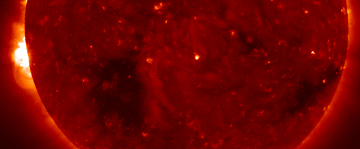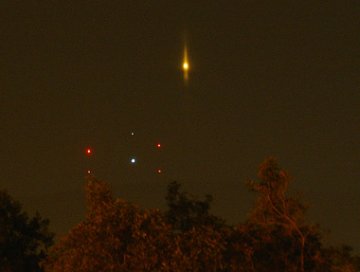 Where's Saturn? Is that a UFO--or the ISS? What's the name of that star? Get the answers from mySKY--a fun new astronomy helper from Meade. Where's Saturn? Is that a UFO--or the ISS? What's the name of that star? Get the answers from mySKY--a fun new astronomy helper from Meade. PLANETS ALIGN: Venus and Saturn are converging for a close encounter on June 30th when the pair will be only 2/3o apart. You can watch the distance shrink in the nights ahead. Step outside after sundown and look west. Venus is the brightest object in the sky; Saturn is the yellow dot right beside it. Sky maps: June 25, 26, 27, 28, 29, 30, July 1. COMING SOON? For the past 12 days, the Sun has been blank (no sunspots) and solar activity has been low. This could soon change. Japan's Hinode spacecraft is monitoring an x-ray hot-spot on the Sun's eastern limb: 
The x-rays may herald an active sunspot just over the horizon. Amateur astronomers with solar telescopes should keep an eye on this region of the Sun for further developments. UPDATE: A sunspot is now emerging over the eastern limb as shown in these images from Guenter Kleinschuster of Feldbach, Styria, Austria; from Dave Tyler of Buckinghamshire UK; from Alcaria Rego of Almada, Portugal; from Howard Eskildsen of Ocala, Florida; from Peter Paice of Belfast, Northern Ireland. VENUS PILLARS: Last night in Quebec City, photographer Dominic Cantin was watching Venus sink toward the western horizon when something extraordinary happened. The planet changed shape, spreading into a vertical column of light: 
Photo details: Pentax *Ist Ds, 800 ASA, 3 sec. exposure
"The phenomenon was clearly visible to unaided eye," says Cantin. "It was a very nice display that lasted until Venus set." More images: #1, #2, #3, #4. These are called Venus pillars, and they are caused by flat, six-sided ice crystals fluttering down from high clouds. The crystals reflect light from their horizontal faces, spreading a single point of light into a luminous column. Among all the objects in the heavens, only the Sun, Moon and Venus are bright enough to produce naked-eye pillars. When the Sun goes down tonight, step outside and look west for your own Venus pillars. If you don't see any, let Saturn be your consolation prize: sky map. | 
